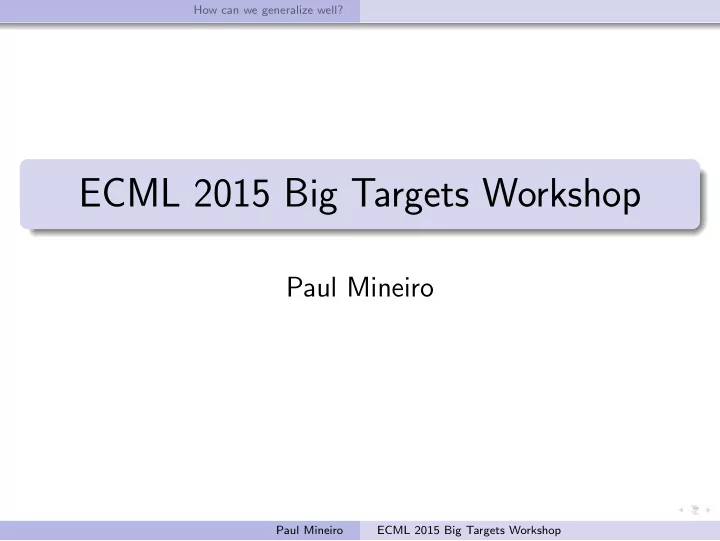

How can we generalize well? ECML 2015 Big Targets Workshop Paul Mineiro Paul Mineiro ECML 2015 Big Targets Workshop
How can we generalize well? Extreme Challenges How can we generalize well? Can we compete with OAA? When can we predict quickly? Paul Mineiro ECML 2015 Big Targets Workshop
How can we generalize well? How can we generalize well? Paul Mineiro ECML 2015 Big Targets Workshop
How can we generalize well? Chasing Tails Typical extreme datasets have many rare classes. Paul Mineiro ECML 2015 Big Targets Workshop
How can we generalize well? Chasing Tails Typical extreme datasets have many rare classes. What are the implications for generalization? Paul Mineiro ECML 2015 Big Targets Workshop
How can we generalize well? Chasing Tails Typical extreme datasets have many rare classes. What are the implications for generalization? Let’s use the bootstrap to get intuition. Paul Mineiro ECML 2015 Big Targets Workshop
How can we generalize well? Bootstrap Lesson Observation (Tail Frequencies) The true frequencies of tail classes is not clear given the training set. Paul Mineiro ECML 2015 Big Targets Workshop
How can we generalize well? Two Loss Patterns All classes below have 1 training example. Which hypothesis do you like better? h 1 h 2 class 1 1 0.6 class 2 1 0.6 class 3 0 0.42 class 4 0 0.42 Paul Mineiro ECML 2015 Big Targets Workshop
How can we generalize well? Two Loss Patterns All classes below have 1 training example. Which hypothesis do you like better? h 1 h 2 class 1 1 0.6 class 2 1 0.6 class 3 0 0.42 class 4 0 0.42 ERM likes h 1 better. I like h 2 better. Paul Mineiro ECML 2015 Big Targets Workshop
How can we generalize well? The Extreme Deficiencies of ERM ERM cares only about average loss. h ∗ = argmin E ( x , y ) ∼ D [ l ( h ( x ); y )] h ∈H . . . but extreme learning empirical losses can have high variance. ERM doesn’t care about empirical loss variance. ERM is based upon a uniform bound on the hypothesis space. Paul Mineiro ECML 2015 Big Targets Workshop
How can we generalize well? eXtreme Risk Minimization Sample Variance Penalization (XRM) penalizes combination of expected loss and loss variance. h ∗ = argmin ( E [ l ( h ( x ); y )] + κ V [ l ( h ( x ); y )]) h ∈H ( κ is a hyperparameter in practice) XRM is based upon empirical Bernstein bounds. Paul Mineiro ECML 2015 Big Targets Workshop
How can we generalize well? Example: Neural Language Modeling Mini-batch XRM gradient: l i ( φ ) − E j [ l j ( φ )] ∂ l i ( φ ) 1 + κ E i � ∂φ � � − E j [ l j ( φ )] 2 l 2 j ( φ ) E j Smaller than average loss = ⇒ lower learning rate Larger than average loss = ⇒ larger learning rate Loss variance is the unit of loss measurement Paul Mineiro ECML 2015 Big Targets Workshop
How can we generalize well? Example: Neural Language Modeling enwiki9 data set FNN-LM of Zhang et. al. Same everything except κ . method perplexity ERM ( κ = 0) 106.3 XRM ( κ = 0.25) 104.1 Modest lift, but over SOTA baseline and with minimal code changes. Paul Mineiro ECML 2015 Big Targets Workshop
How can we generalize well? Example: Neural Language Modeling Progressive Loss Variance 4 3 ERM 2 XRM 1 0 10 4 10 6 10 8 10 10 Example # Paul Mineiro ECML 2015 Big Targets Workshop
How can we generalize well? Example: Randomized Embeddings Based upon (randomized) SVD. d k c c V ⊤ k ≈ T d X Y n n W = TV ⊤ How to adapt black-box technique to XRM? Idea: proxy model = ⇒ importance weights. Paul Mineiro ECML 2015 Big Targets Workshop
How can we generalize well? Imbalanced binary XRM Binary classification with constant predictor. l ( y ; q ) = y log( q ) + (1 − y ) log(1 − q ) � l ( y ; q ) − E [ l ( · ; q )] � 1 + κ � � � E [ l 2 ( · ; q )] − E [ l ( · ; q )] 2 � q = p � p 1 − κ y = 0 1 − p = ( p ≤ 0 . 5) � 1 − p 1 + κ y = 1 p Paul Mineiro ECML 2015 Big Targets Workshop
How can we generalize well? XRM Rembed for ODP Compute base rate q c each class c . Importance weight (1 + κ (1 / √ q y i )). method error rate (%) ODP ERM [80.3, 80.4] ODP XRM ( κ = 1) [78.5, 78.7] Modest lift, but over SOTA baseline and with minimal code changes. Paul Mineiro ECML 2015 Big Targets Workshop
How can we generalize well? Summary The tail can deviate wildly between train and test. Controlling loss variance helps a little bit. Speculation: explicitly treat the head and tail differently? Paul Mineiro ECML 2015 Big Targets Workshop
Recommend
More recommend